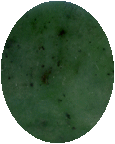| |
Jade
|
Jade is a common name for two closely related materials with a very similar appearance, jadeite and nephrite. The word Jade is the only gem whose name is derived from Spanish, rather than Greek or Latin. The word is a corruption of piedra de ijada, or stone of the flank. This name most likely originated due to the botryoidal nephrite’s resemblance to a kidney. The earliest lapidaries reflect this belief in the claim that the stone could cure all diseases of the kidneys.
Though diamonds are the hardest of stones, jade is durable. It’s crystalline structure is fibrous in nature allowing for impacts to be absorbed across the stone. This durability earned jade a reputation as an excellent material for tools and everything from weapons of war to ceremonial alters.
The demand for jade by ruling classes of many early cultures only enshrined the stones association with prosperity. This connection with wealth and nobility can be seen in the use of jade in jewelry, weapons, and ceremonial objects. It is unique in that many unrelated cultures independently assigned similar value to the stone and objects made from it.
Jade is also said to grant longevity and preserve life. Many cultures have jade charms and amulets to protect everything from children and the bones of the elderly. This close association with jade and essence of life is often extended to the ancestors in many cultures. The Han dynasty in China created jade burial suits and talismans to protect the spirit of royal family members. For the Māori of New Zealand jade is the stone of choice for the hei-tiki, a carved necklace of a humanoid figure. They are often buried with honored dead such as the kaitiaki, or guardian of a place.
|
Colors
|
Green is most common however it can be found in several colors.
|
Locations
|
Jade is found worldwide.
|
Compisition
|
NaAlSi2O6
or
Ca2(Mg, Fe)5Si8O22(OH)2
|
Hardness
|
6 - 7
|
|

|

|

|
|
|
|
|
|